CJ400 - Criminal Psychology Report: Biological and Learning Factors
VerifiedAdded on 2022/08/25
|5
|1057
|18
Report
AI Summary
This report delves into the genetic and biological underpinnings of criminal behavior, examining the influence of both. It explores the role of behavioral genetics, highlighting studies on twins and adoptees that demonstrate the impact of heredity on antisocial traits. The report also discusses biological factors, including personality traits and environmental risk factors. Furthermore, the report investigates the Eysenck's theory of Criminal Personality, which suggests that personality is biologically based and influences criminal activities. The report also covers learning and situational factors, including social learning theory, differential association, and differential reinforcement. It references Bandura's social learning theory, emphasizing the role of observation and imitation in acquiring criminal behavior. The report also examines Sutherland's differential association theory and Akers' social learning theory, providing a comprehensive overview of the factors influencing criminal behavior.
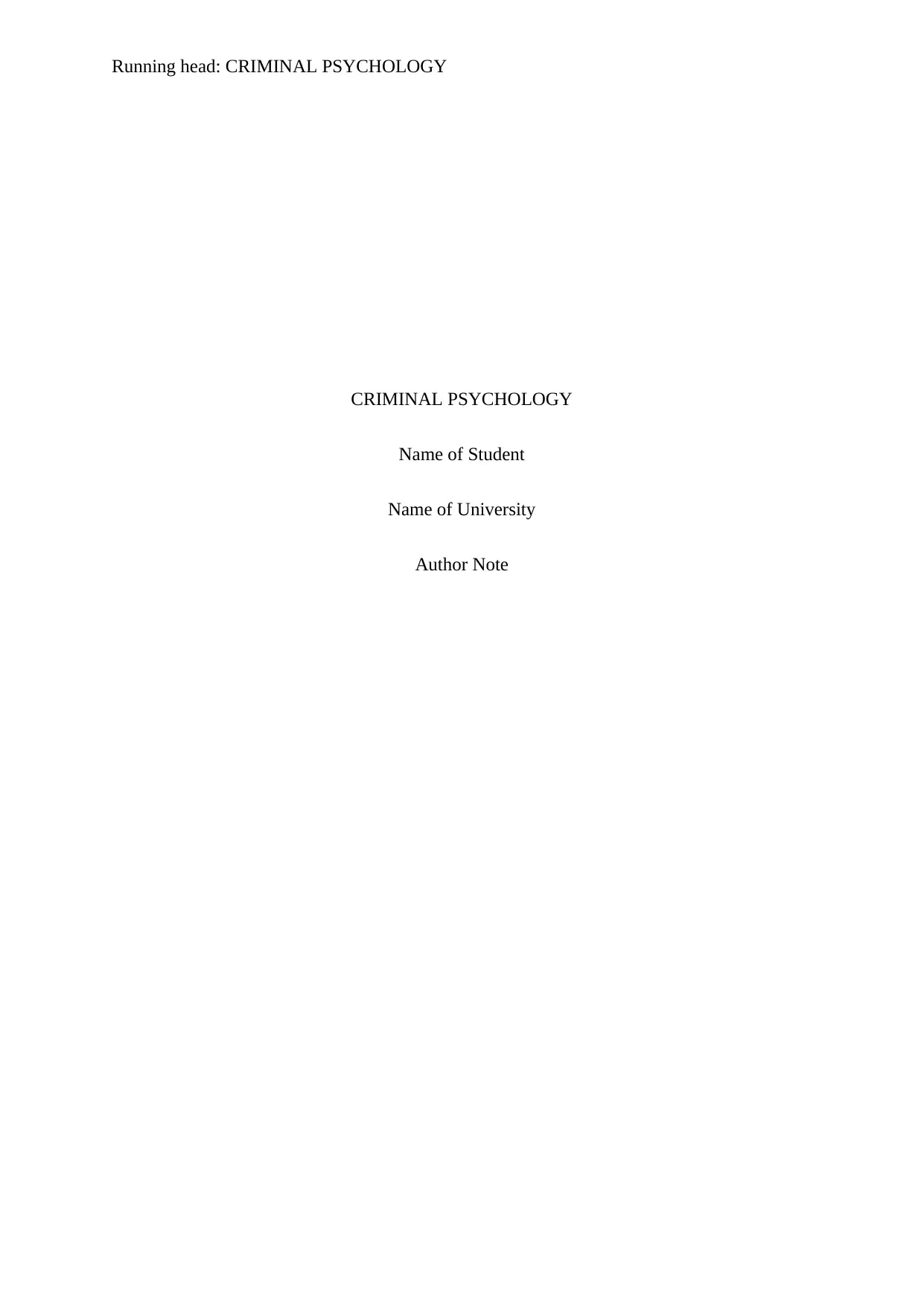
Running head: CRIMINAL PSYCHOLOGY
CRIMINAL PSYCHOLOGY
Name of Student
Name of University
Author Note
CRIMINAL PSYCHOLOGY
Name of Student
Name of University
Author Note
Paraphrase This Document
Need a fresh take? Get an instant paraphrase of this document with our AI Paraphraser
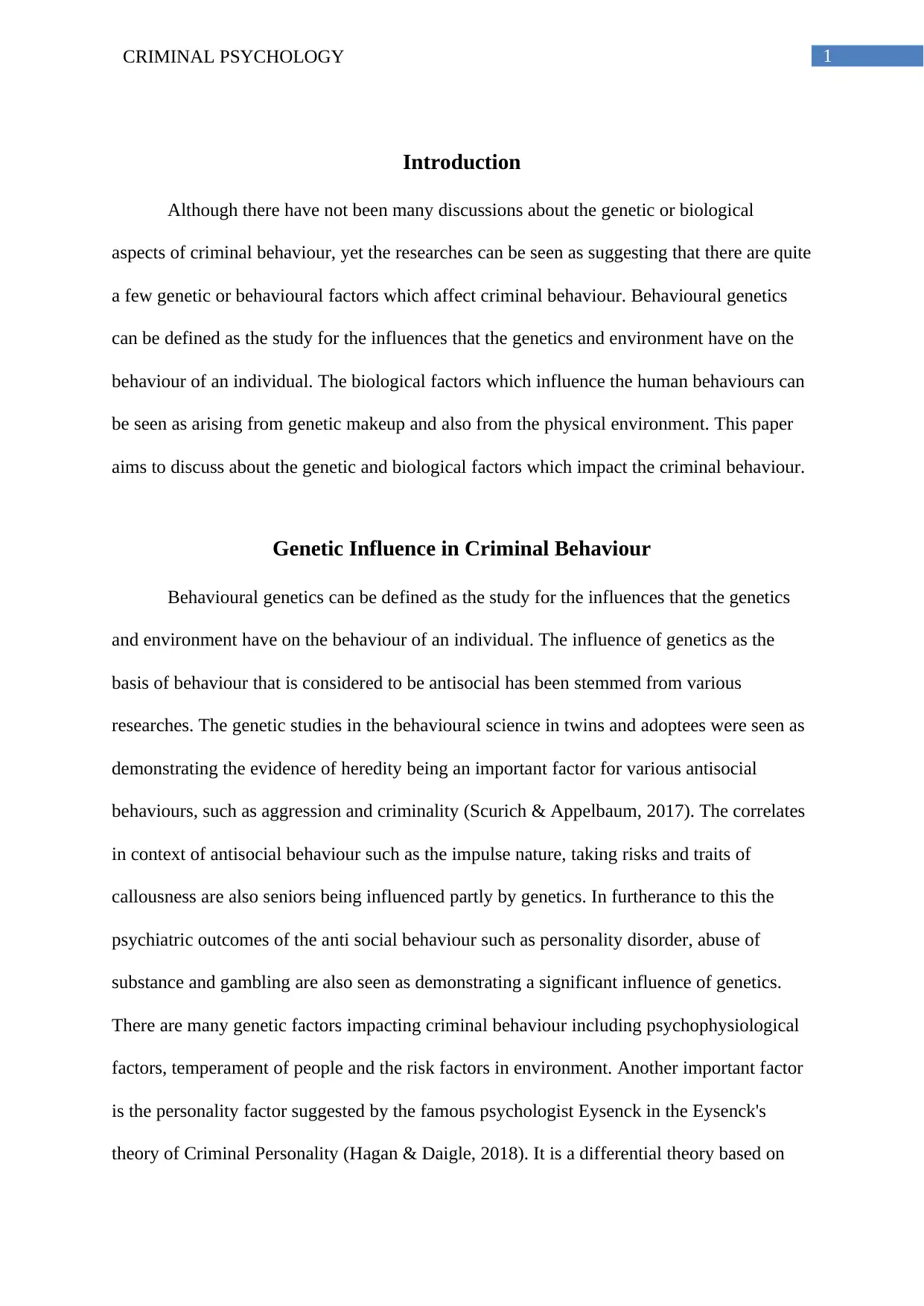
1CRIMINAL PSYCHOLOGY
Introduction
Although there have not been many discussions about the genetic or biological
aspects of criminal behaviour, yet the researches can be seen as suggesting that there are quite
a few genetic or behavioural factors which affect criminal behaviour. Behavioural genetics
can be defined as the study for the influences that the genetics and environment have on the
behaviour of an individual. The biological factors which influence the human behaviours can
be seen as arising from genetic makeup and also from the physical environment. This paper
aims to discuss about the genetic and biological factors which impact the criminal behaviour.
Genetic Influence in Criminal Behaviour
Behavioural genetics can be defined as the study for the influences that the genetics
and environment have on the behaviour of an individual. The influence of genetics as the
basis of behaviour that is considered to be antisocial has been stemmed from various
researches. The genetic studies in the behavioural science in twins and adoptees were seen as
demonstrating the evidence of heredity being an important factor for various antisocial
behaviours, such as aggression and criminality (Scurich & Appelbaum, 2017). The correlates
in context of antisocial behaviour such as the impulse nature, taking risks and traits of
callousness are also seniors being influenced partly by genetics. In furtherance to this the
psychiatric outcomes of the anti social behaviour such as personality disorder, abuse of
substance and gambling are also seen as demonstrating a significant influence of genetics.
There are many genetic factors impacting criminal behaviour including psychophysiological
factors, temperament of people and the risk factors in environment. Another important factor
is the personality factor suggested by the famous psychologist Eysenck in the Eysenck's
theory of Criminal Personality (Hagan & Daigle, 2018). It is a differential theory based on
Introduction
Although there have not been many discussions about the genetic or biological
aspects of criminal behaviour, yet the researches can be seen as suggesting that there are quite
a few genetic or behavioural factors which affect criminal behaviour. Behavioural genetics
can be defined as the study for the influences that the genetics and environment have on the
behaviour of an individual. The biological factors which influence the human behaviours can
be seen as arising from genetic makeup and also from the physical environment. This paper
aims to discuss about the genetic and biological factors which impact the criminal behaviour.
Genetic Influence in Criminal Behaviour
Behavioural genetics can be defined as the study for the influences that the genetics
and environment have on the behaviour of an individual. The influence of genetics as the
basis of behaviour that is considered to be antisocial has been stemmed from various
researches. The genetic studies in the behavioural science in twins and adoptees were seen as
demonstrating the evidence of heredity being an important factor for various antisocial
behaviours, such as aggression and criminality (Scurich & Appelbaum, 2017). The correlates
in context of antisocial behaviour such as the impulse nature, taking risks and traits of
callousness are also seniors being influenced partly by genetics. In furtherance to this the
psychiatric outcomes of the anti social behaviour such as personality disorder, abuse of
substance and gambling are also seen as demonstrating a significant influence of genetics.
There are many genetic factors impacting criminal behaviour including psychophysiological
factors, temperament of people and the risk factors in environment. Another important factor
is the personality factor suggested by the famous psychologist Eysenck in the Eysenck's
theory of Criminal Personality (Hagan & Daigle, 2018). It is a differential theory based on
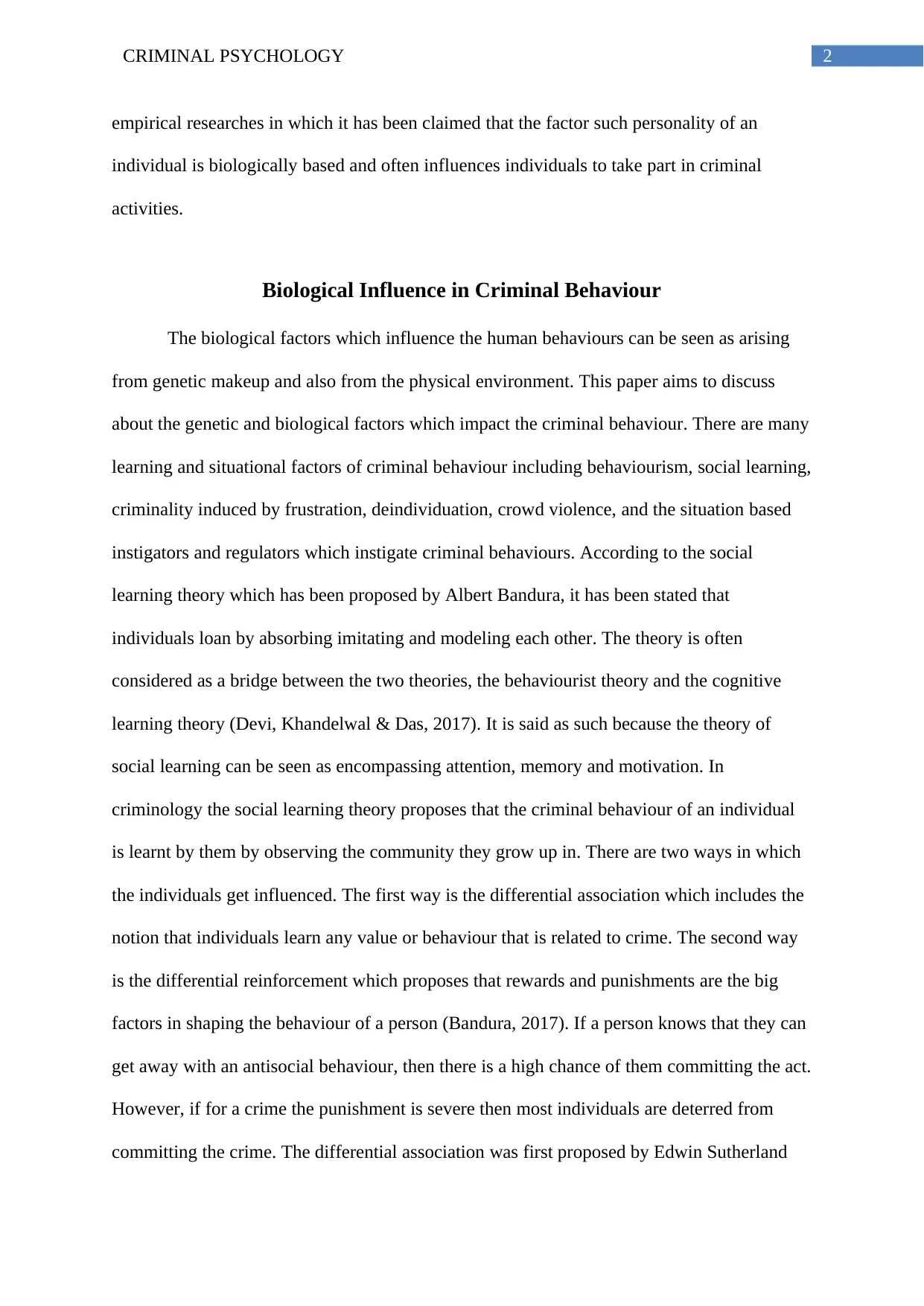
2CRIMINAL PSYCHOLOGY
empirical researches in which it has been claimed that the factor such personality of an
individual is biologically based and often influences individuals to take part in criminal
activities.
Biological Influence in Criminal Behaviour
The biological factors which influence the human behaviours can be seen as arising
from genetic makeup and also from the physical environment. This paper aims to discuss
about the genetic and biological factors which impact the criminal behaviour. There are many
learning and situational factors of criminal behaviour including behaviourism, social learning,
criminality induced by frustration, deindividuation, crowd violence, and the situation based
instigators and regulators which instigate criminal behaviours. According to the social
learning theory which has been proposed by Albert Bandura, it has been stated that
individuals loan by absorbing imitating and modeling each other. The theory is often
considered as a bridge between the two theories, the behaviourist theory and the cognitive
learning theory (Devi, Khandelwal & Das, 2017). It is said as such because the theory of
social learning can be seen as encompassing attention, memory and motivation. In
criminology the social learning theory proposes that the criminal behaviour of an individual
is learnt by them by observing the community they grow up in. There are two ways in which
the individuals get influenced. The first way is the differential association which includes the
notion that individuals learn any value or behaviour that is related to crime. The second way
is the differential reinforcement which proposes that rewards and punishments are the big
factors in shaping the behaviour of a person (Bandura, 2017). If a person knows that they can
get away with an antisocial behaviour, then there is a high chance of them committing the act.
However, if for a crime the punishment is severe then most individuals are deterred from
committing the crime. The differential association was first proposed by Edwin Sutherland
empirical researches in which it has been claimed that the factor such personality of an
individual is biologically based and often influences individuals to take part in criminal
activities.
Biological Influence in Criminal Behaviour
The biological factors which influence the human behaviours can be seen as arising
from genetic makeup and also from the physical environment. This paper aims to discuss
about the genetic and biological factors which impact the criminal behaviour. There are many
learning and situational factors of criminal behaviour including behaviourism, social learning,
criminality induced by frustration, deindividuation, crowd violence, and the situation based
instigators and regulators which instigate criminal behaviours. According to the social
learning theory which has been proposed by Albert Bandura, it has been stated that
individuals loan by absorbing imitating and modeling each other. The theory is often
considered as a bridge between the two theories, the behaviourist theory and the cognitive
learning theory (Devi, Khandelwal & Das, 2017). It is said as such because the theory of
social learning can be seen as encompassing attention, memory and motivation. In
criminology the social learning theory proposes that the criminal behaviour of an individual
is learnt by them by observing the community they grow up in. There are two ways in which
the individuals get influenced. The first way is the differential association which includes the
notion that individuals learn any value or behaviour that is related to crime. The second way
is the differential reinforcement which proposes that rewards and punishments are the big
factors in shaping the behaviour of a person (Bandura, 2017). If a person knows that they can
get away with an antisocial behaviour, then there is a high chance of them committing the act.
However, if for a crime the punishment is severe then most individuals are deterred from
committing the crime. The differential association was first proposed by Edwin Sutherland
⊘ This is a preview!⊘
Do you want full access?
Subscribe today to unlock all pages.

Trusted by 1+ million students worldwide
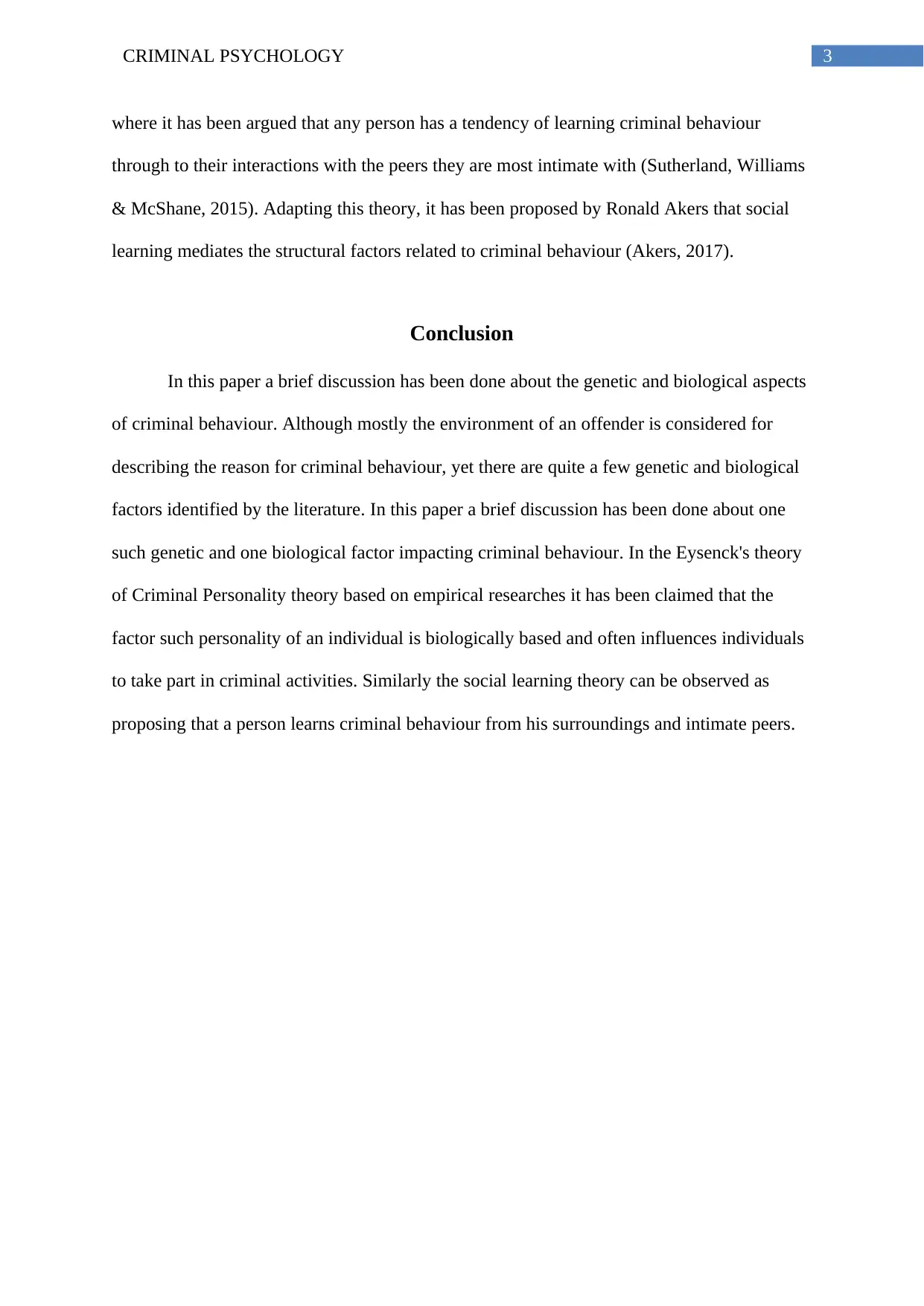
3CRIMINAL PSYCHOLOGY
where it has been argued that any person has a tendency of learning criminal behaviour
through to their interactions with the peers they are most intimate with (Sutherland, Williams
& McShane, 2015). Adapting this theory, it has been proposed by Ronald Akers that social
learning mediates the structural factors related to criminal behaviour (Akers, 2017).
Conclusion
In this paper a brief discussion has been done about the genetic and biological aspects
of criminal behaviour. Although mostly the environment of an offender is considered for
describing the reason for criminal behaviour, yet there are quite a few genetic and biological
factors identified by the literature. In this paper a brief discussion has been done about one
such genetic and one biological factor impacting criminal behaviour. In the Eysenck's theory
of Criminal Personality theory based on empirical researches it has been claimed that the
factor such personality of an individual is biologically based and often influences individuals
to take part in criminal activities. Similarly the social learning theory can be observed as
proposing that a person learns criminal behaviour from his surroundings and intimate peers.
where it has been argued that any person has a tendency of learning criminal behaviour
through to their interactions with the peers they are most intimate with (Sutherland, Williams
& McShane, 2015). Adapting this theory, it has been proposed by Ronald Akers that social
learning mediates the structural factors related to criminal behaviour (Akers, 2017).
Conclusion
In this paper a brief discussion has been done about the genetic and biological aspects
of criminal behaviour. Although mostly the environment of an offender is considered for
describing the reason for criminal behaviour, yet there are quite a few genetic and biological
factors identified by the literature. In this paper a brief discussion has been done about one
such genetic and one biological factor impacting criminal behaviour. In the Eysenck's theory
of Criminal Personality theory based on empirical researches it has been claimed that the
factor such personality of an individual is biologically based and often influences individuals
to take part in criminal activities. Similarly the social learning theory can be observed as
proposing that a person learns criminal behaviour from his surroundings and intimate peers.
Paraphrase This Document
Need a fresh take? Get an instant paraphrase of this document with our AI Paraphraser
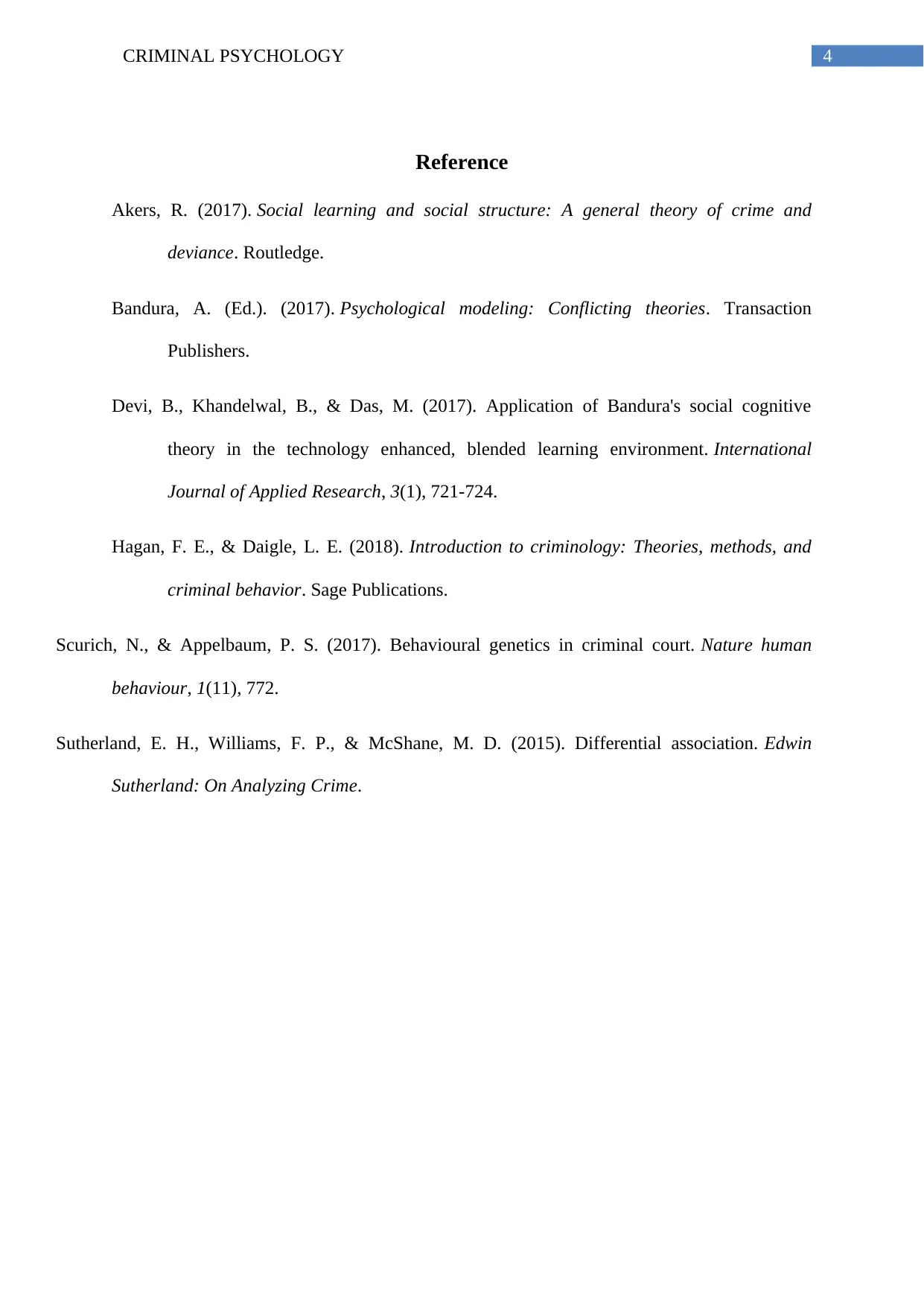
4CRIMINAL PSYCHOLOGY
Reference
Akers, R. (2017). Social learning and social structure: A general theory of crime and
deviance. Routledge.
Bandura, A. (Ed.). (2017). Psychological modeling: Conflicting theories. Transaction
Publishers.
Devi, B., Khandelwal, B., & Das, M. (2017). Application of Bandura's social cognitive
theory in the technology enhanced, blended learning environment. International
Journal of Applied Research, 3(1), 721-724.
Hagan, F. E., & Daigle, L. E. (2018). Introduction to criminology: Theories, methods, and
criminal behavior. Sage Publications.
Scurich, N., & Appelbaum, P. S. (2017). Behavioural genetics in criminal court. Nature human
behaviour, 1(11), 772.
Sutherland, E. H., Williams, F. P., & McShane, M. D. (2015). Differential association. Edwin
Sutherland: On Analyzing Crime.
Reference
Akers, R. (2017). Social learning and social structure: A general theory of crime and
deviance. Routledge.
Bandura, A. (Ed.). (2017). Psychological modeling: Conflicting theories. Transaction
Publishers.
Devi, B., Khandelwal, B., & Das, M. (2017). Application of Bandura's social cognitive
theory in the technology enhanced, blended learning environment. International
Journal of Applied Research, 3(1), 721-724.
Hagan, F. E., & Daigle, L. E. (2018). Introduction to criminology: Theories, methods, and
criminal behavior. Sage Publications.
Scurich, N., & Appelbaum, P. S. (2017). Behavioural genetics in criminal court. Nature human
behaviour, 1(11), 772.
Sutherland, E. H., Williams, F. P., & McShane, M. D. (2015). Differential association. Edwin
Sutherland: On Analyzing Crime.
1 out of 5
Related Documents
Your All-in-One AI-Powered Toolkit for Academic Success.
+13062052269
info@desklib.com
Available 24*7 on WhatsApp / Email
![[object Object]](/_next/static/media/star-bottom.7253800d.svg)
Unlock your academic potential
Copyright © 2020–2025 A2Z Services. All Rights Reserved. Developed and managed by ZUCOL.




